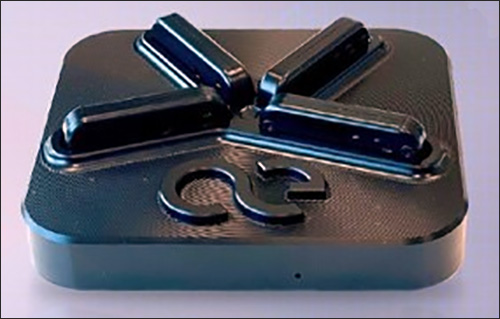American Equus has developed a wearable sensor that tracks the health and conditions of racehorses. The device, which comes with built-in wireless or contact charging provided by Energous, can be attached to a horse’s leg in order to monitor the animal’s vital statistics, such as temperature, heart rate and leg positioning. The sensor can track an animal’s average statistics and detect deviations that might indicate an injury, the company explains, allowing trainers or owners to respond to that information quickly and thereby prevent further harm.
The device, known as EQx VitalsSensor, has a built-in Bluetooth Low Energy (BLE) radio that transmits sensor data to cloud-based software in real time so that users can monitor each horse’s health as it races or trains. In addition to multiple sensors and the BLE radio, the device includes Energous’s WattUp wireless charging technology, which supports both contact and over-the-air charging. The WattUp wireless charging functionality has implications for the RFID and Internet of Things (IoT) industries, according to Stephen R. Rizzone, the firm’s president and CEO. By sending a charge across a distance, he says, a variety of wireless sensor devices could continue operation without requiring a wired power source.

The EQx VitalsSensor
Initially, the company indicates, the EQx VitalsSensor will leverage a contact-based charging pad that sends RF-based power to the American Equus devices, even if multiple units are placed on the pad simultaneously. In the longer term, however, the sensors will be energized using WattUp wireless charging across a distance of several meters, making it faster and more automatic to charge the devices when they are not in use.
American Equus serves a customer base comprising horse owners, trainers and veterinarians. The company was launched to offer a better horse stirrup, and the Arizona-based firm now also provides spurs, gloves and horseshoes. Its EQx VitalsSensor system is the first such technology-based product, the company reports. American Equus created the sensor in partnership with industrial design company 28Gorilla and the technology is being built by Imagine Manufacturing.
The waterproof health-tracking device is attached to the lower part of each horse’s leg via an ankle wrap or boot. Typically, one sensor is attached to each of the four legs, then data regarding temperature and other conditions is transmitted via BLE, either to a mobile phone carried by a rider or trainer, or to a monitoring station. If any deviation occurs, that event will be captured and an alarm to the user will thus be prompted, thereby indicating a possible injury to the horse’s tendon.
The horse-racing industry had a difficult year in 2020, according to David Shano, American Equus’s founder, due to a number of injuries experienced during training and racing. “Horse suspensory injuries are particularly devastating,” he explains, “as often the horse must be put down.” The EQx VitalsSensor is designed to alleviate that issue, he adds, by detecting leg injuries and alerting those responsible for the animals so that they can diagnose the problem before it can become more serious. The sensors are designed to be nonintrusive to the riders or horses, and to be waterproof in muddy environments, which means they must have no charging ports that can become dirty.
Energous was launched eight years ago to provide wireless power, and its solutions can provide both contact- and distance-based power with the same product. “The fundamental issue with us,” Rizzone says, “is providing wireless power to devices both through the air at a distance or at contact.” The company spent the first few years of development looking at different RF frequencies for charging, Rizzone recalls. Because a radio signal is used, he notes, the system requires certification, but until recently, “There’s been no path for global certification of [such an] RF power source.” Therefore, the firm has been working with regulators to create that certification.
To date, Rizzone reports, the best early applications for RF charging have involved wearable sensors. “That’s what led us to American Equus,” he states, describing the horse-racing products firm as “a very progressive company focused on monitoring the health of horses.” Energous provided the RF receiver in the sensor device, including an antenna, as well as a module measuring 4 millimeters by 6 millimeters (0.16 inch by 0.24 inch)—which comes with interface, control and converter—to receive and convert power to DC and then provide that power for the sensors and Bluetooth radio.

Stephen R. Rizzone
For the first-generation devices, horses will wear four ankle sensors while moving around the track. When the devices require charging, all four can be placed on a pad provided by Energous. The RF-based charging system, Rizzone says, differs from what has been the first generation of wireless charging technology, which employs inductive coils that must be matched in order to enable magnetic energy to be transferred to the device. The Energous version utilizes an RF antenna to send that charge. While initial applications are contact-based, he expects them to migrate to over-the-air charging.
Energous’s technology transmits RF-energizing power from a distance of up to several meters. The company already sells RF-based charging solutions for several other products. For instance, a hearing aid can now be powered wirelessly with the same WattUp-enabled products. The first product leveraging the WattUp technology is a personal sound-amplification product similar to a hearing aid, provided by South Korean technology company Delight. By early next year, Rizzone predicts that the same transmitters will be built into RFID asset tags to be charged at a distance.

David Shano
The company has been in discussions with a variety of technology companies, and Rizzone expects the energizing range to be relatively long for RFID tags, in part because the power requirements for such tags are in the microvolts levels. “You’re not blasting large amounts of power,” he explains. Examples would include UHF RFID tags with LCD screens, such as RFID-enabled shelf tags that display prices. As such, he adds, tags and sensors provide more features as the requirement for power is growing. “The more information and the more technology evolves, the more power it is going to require.”
Medical sensors would be another power-hungry technology, with mobile tags that provide temperature data captured by a digital thermometer, or a sensor datalogger in the supply chain, or a security camera or watch worn in a consumer’s home. RFID-based implants could be powered and thereby provide functionality without a person physically accessing the device. On the other hand, a variety of devices used by drivers could be charged in cars.
American Equus tested the wearable sensor in a real-world environment, Shano says. “The data from testing is consistent with our preliminary simulations,” he states, “and we’re excited to bring this product to market and help provide real-time performance data for the horse-racing industry.” For Energous, Rizzone adds, “This is kind of the precursor for us into our movement into broader sensor applications,” which could include RFID tags and other wireless asset-tracking technologies.


